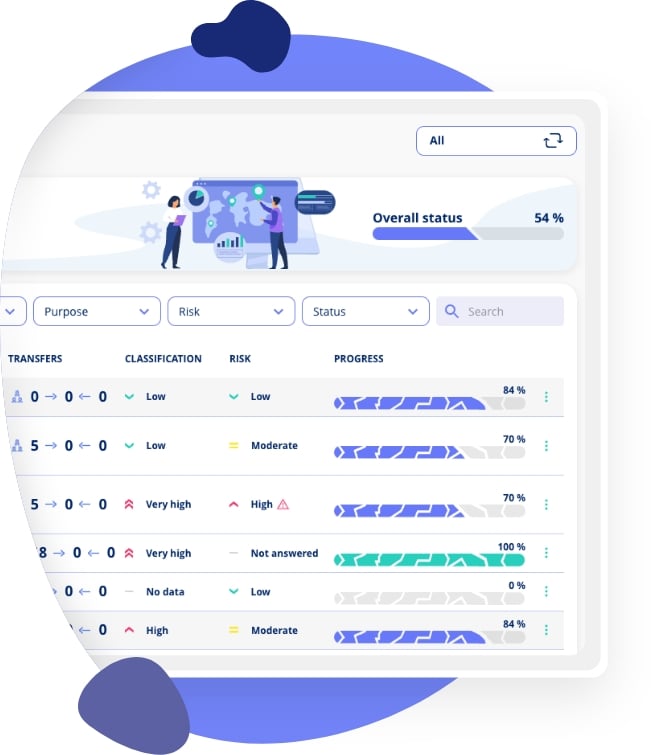Vendor Audits
In this article, we look at how you can effectively oversee your suppliers’ IT security, protect your business, and meet the requirements of GDPR, NIS2, and ISO 27001.

- Articles
- Information Security Management
- Vendor audits
Table of Contents
How to audit your suppliers’ IT security
These days, every business uses suppliers to handle parts of their operations, whether cloud platforms, accounting software, HR services, consultants or IT management. It’s both efficient and necessary to outsource tasks to suppliers, but every time you outsource a task, new risks come into play because while you can outsource the work, you cannot outsource the responsibility.
It’s better to view your outsourcing as an extension of your own organisation. If a security breach occurs at one of your suppliers, it can have direct consequences for you, both in terms of operations and legal obligations.
So, auditing your suppliers is good practice and an essential control mechanism to ensure that your own responsibilities are not undermined by insecure practices on their side. Oversight is what gives you insight into how the supplier manages IT security and whether they are complying with the terms of your contract. If you don’t do this, you have no real way of knowing if the risks are being handled properly.
This article goes through how to organise and carry out audits of your suppliers’ IT security, whether you work in a small business with just a few suppliers or a larger organisation with more complex supplier relationships.
Why audit suppliers?
The purpose of auditing is to make sure that your suppliers are complying with the agreed security measures, contractual obligations and legal obligations, which your organisation is also subject to under GDPR, NIS2 or possibly even the ISO27001 standard, for example.
This means your business needs to establish and operate a structured process for auditing and controlling your suppliers’ IT security: from due diligence and contract signing to ongoing audits and the eventual end of the contractual agreement.
Failing to audit your suppliers can have serious consequences, including data breaches, operational losses, fines from regulators, loss of trust from customers and partners and potential contractual or financial losses.
Legal requirements and standards
Several regulations and industry standards, such as GDPR, NIS2 and the ISO27001 standard, require you to audit your suppliers.
GDPR
GDPR sets out clear rules on how organisations must handle their data processors, not only upon signing the contract but also during ongoing cooperation. The key point is that you, as the data controller, must maintain control even if personal data is handled by an external supplier. This means having written data processing agreements in place, applying suitable security measures and ensuring your supplier handles any security breaches properly and promptly.
It is also important to pay attention if your supplier processes data outside the EU. In such cases, GDPR requires that you have the necessary safeguards in place.
All of this is a central part of managing data processors. If you want to explore how to audit them in more detail, we recommend reading our separate article on the topic.
NIS2
With NIS2, the EU has raised the bar for how organisations classified as critical infrastructure must handle IT security. This now includes your supply chain and, therefore, your relationships with suppliers and subcontractors. It is no longer enough to simply manage your own staff and systems. You must also be able to document why and how you set requirements for your suppliers and how you audit them.
You need to assess the risks linked to the supplier’s service, especially how those risks could affect the delivery of your own critical services.
This begins with having a clear overview of your suppliers and assessing the risk associated with each one. You must then ensure that your contracts reflect those risks and that your suppliers and their subcontractors are actually meeting the requirements in practice; this must be verified through your auditing.
Article 23 of NIS2 also states that management is responsible for overseeing and approving the organisation’s risk management, including the handling of supplier-related risks.
ISO27001
The ISO27001 standard sets requirements for how organisations should manage information security, including tasks that have been outsourced to suppliers. Risks related to external parties must be assessed and managed just like internal risks. You need to know what assets suppliers have access to, how access is controlled and how their handling of information and systems is audited.
The controls of the standard cover setting requirements in contracts, managing access to information and systems, auditing the supplier’s security level and handling changes in the delivery. You also need to consider the security of the entire supply chain and ensure that subcontractors meet the same requirements.
Security controls no. 5.19 to 5.23 in ISO27001:2022 cover these areas and form the foundation for structured supplier audits.
Supplier management: before, during and after the relationship
Supplier management starts with selecting suppliers and ends only when the task and all associated obligations have been completed. Auditing of suppliers can take place before, during and after the relationship.
Before signing a contract
Before you outsource a task to a supplier, you should carry out a risk assessment of the task. This helps you define suitable security requirements for the supplier. These could include access control, encryption, incident handling, auditing and documentation. This is also the stage where you define your right to audit the supplier and possibly even their subcontractors. It often requires collaboration with procurement, legal and other business areas to ensure the requirements are both legally and practically anchored.
Auditing during the relationship
Once the cooperation is underway, your audit is about ensuring that the supplier complies with the agreed requirements and that these are suited to their risk profile.
The risk profile depends on whether the supplier has access to sensitive data or provides critical services. This should also be reflected in the required security measures.
Your audit can be carried out through document reviews, status meetings, third-party assessments of the supplier or by visiting them yourself to check that the agreed conditions are being followed.
It is also important to act if the supplier changes systems, processes or other parts of their organisation because these changes can affect security. The supplier should be required to notify you of such changes. This should be set out in the contract and is also something that should be audited.
Auditing might include checking how the supplier manages access control, uses encryption, handles software updates, conducts IT security awareness training and deals with incidents. Another relevant aspect is to review the supplier’s documentation, such as ISO certificates, internal audits or assurance reports, such as ISAE 3402. At the same time, you should find out whether the supplier uses subcontractors and how they are held to the same requirements so that you can trust that the entire supply chain is secure.
After the contract ends
When the contract and cooperation come to an end, you need to make sure that the supplier’s access, data processing and so on are properly closed down. This might also involve an audit to confirm that the contractual terms for ending the cooperation have been followed.
Audit model and internal resources
Your auditing approach should reflect your organisation’s resources and complexity. A small organisation and a large organisation will have very different needs and possibilities when it comes to supplier management.
Smaller organisations
In smaller organisations, auditing is often handled by one person who also has many other responsibilities. In that case, it is important to prioritise and focus on the few suppliers who pose the greatest risk. Assessments and audits can be documented using simple templates or spreadsheets. Vendor management software can also be useful to give structure and an overview and help one person get more done.
Larger organisations
In larger organisations, there are usually more suppliers, more system owners and higher demands around governance and documentation. Supplier management should be a dedicated role or function with links to IT, compliance, legal and procurement. Suppliers should be placed into risk categories, with the frequency and depth of audits adjusted accordingly. For the most critical suppliers, annual audits might be needed, while lower-risk ones may only require a simpler follow-up.
Vendor management software should be used to handle the complexity of dealing with all the different suppliers, contracts, requirements, audits, documentation and coordination across business areas.
Conclusion
Auditing suppliers gives you clarity, improves security and shows that your business is in control.
Start by getting an overview of your suppliers, carrying out risk assessments and making sure that the key requirements are written into your contracts. Use a simple tool to follow up and make audits a regular part of your security work.




.jpeg)

.jpg)
.jpg)



.jpg)

-1.png)



.jpeg)








.jpg)





Info
.legal A/S
hello@dotlegal.com
+45 7027 0127
VAT-no: DK40888888
Support
support@dotlegal.com
+45 7027 0127
Need help?
Let me help you get started

+45 7027 0127 and I'll get you started
.legal is not a law firm and is therefore not under the supervision of the Bar Council.




